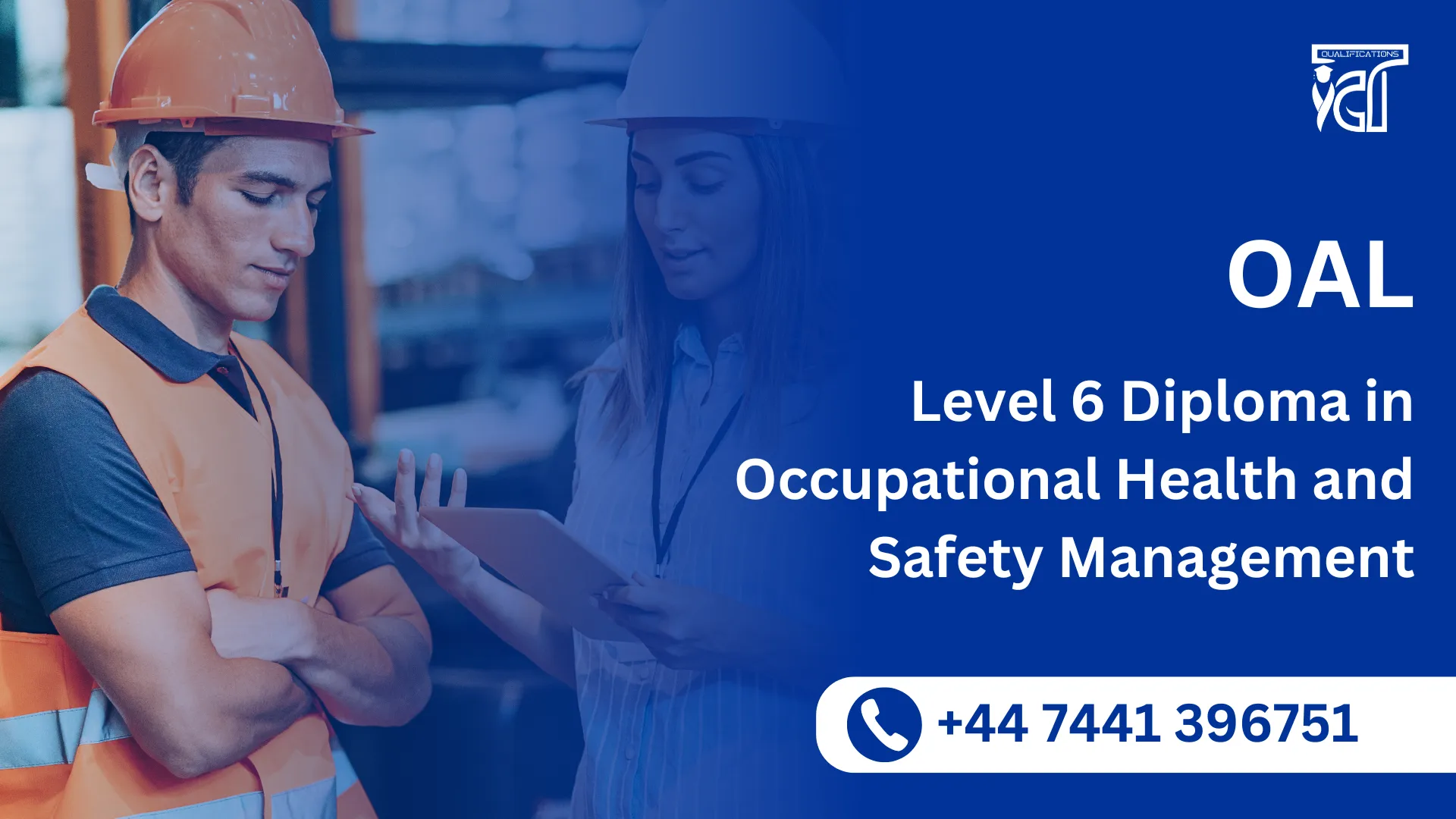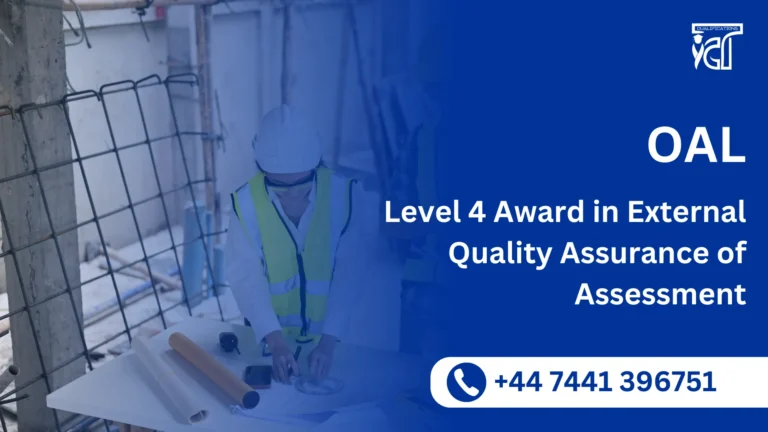The OAL Level 6 Diploma in Occupational Health and Safety Management is a high-level, internationally respected qualification designed for professionals responsible for leading, developing, and maintaining health and safety policies within an organisation. As workplace safety becomes increasingly central to operational success and legal compliance, this diploma equips learners with the strategic knowledge and leadership capabilities required to manage complex health and safety systems at a senior level.
Awarded by Occupational Awards Limited (OAL), the Level 6 Diploma in Occupational Health and Safety Management is designed to be equivalent to a bachelor’s degree in the UK’s qualification framework. It is targeted at professionals who already have a strong foundation in health and safety and are ready to progress into senior management roles.
This diploma develops the technical expertise, strategic thinking, and leadership skills needed to create, maintain, and improve safety management systems. It aligns with key industry standards and regulatory frameworks, making it highly relevant for sectors such as construction, manufacturing, energy, logistics, oil and gas, healthcare, and more.
The course content covers a wide range of subjects, enabling learners to understand the legislative framework, manage risks, lead audits, and foster a culture of continuous improvement. This qualification also prepares learners to effectively lead safety teams, influence board-level decisions, and integrate health and safety into broader business strategies.
The OAL Level 6 Diploma in Occupational Health and Safety Management is a career-defining qualification for professionals seeking to take on senior responsibilities in safety, compliance, and risk management. With its focus on strategic thinking, legal understanding, and practical leadership, this diploma prepares learners to make informed decisions that protect people, enhance workplace performance, and ensure regulatory compliance. Whether aiming for chartered status or leading organisational safety culture, this qualification is a powerful step forward in your professional journey.
OAL Level 6 Diploma in Occupational Health and Safety Management
The OAL Level 6 Diploma in Occupational Health and Safety Management consists of 8 units :
- Develop the health and safety policy
- Prepare to implement the health and safety policy
- Manage work-based hazards through control measures
- Manage emergency response procedures
- Manage organisational health and safety competence and training
- Manage proactive health and safety monitoring in the workplace
- Manage reactive health and safety monitoring in the workplace
- Review health and safety management systems
GLH (Guided Learning Hours) and TQT (Total Qualification Time) are terms commonly used in vocational qualifications to help define the amount of time a learner is expected to spend on their studies.
1. GLH (Guided Learning Hours)
GLH refers to the number of hours a learner spends being directly taught, supervised, or supported during their course. This includes the time spent in activities such as:
- Classroom instruction
- Practical workshops
- One-on-one tutoring or mentoring sessions
- Online learning sessions with tutor support
In other words, GLH represents the time that learners are actively engaged with their instructors or learning activities.
2. TQT (Total Qualification Time)
TQT represents the total amount of time a learner is expected to invest in completing a qualification, including:
- GLH (Guided Learning Hours): Time spent on direct learning, as explained above.
- Self-Directed Learning: This includes time spent on independent study, research, assignment completion, preparation for exams, and any other work the learner does outside of direct teaching hours.
TQT is a broader measure that includes all the time required to achieve the qualification. It helps learners and employers understand the overall commitment required for the qualification.
Key Differences Between GLH and TQT:
- GLH focuses on direct learning with guidance or supervision.
- TQT includes GLH as well as independent study time and other learning-related activities.
Example:
If a qualification has a TQT of 600 hours and a GLH of 250 hours, it means the learner should spend 250 hours in direct learning (classroom, online, or tutor-led sessions) and 350 hours on independent study or research.
Upon completing this Course students will be able to:
1. Develop the Health and Safety Policy
Learning Outcomes:
- Analyse the legal and organisational requirements for a health and safety policy.
- Develop a comprehensive health and safety policy aligned with organisational objectives.
- Define roles, responsibilities, and arrangements within the policy.
- Ensure stakeholder engagement and communication of the policy across the organisation.
2. Prepare to Implement the Health and Safety Policy
Learning Outcomes:
- Plan the resources and actions required for effective policy implementation.
- Identify and address barriers to implementation.
- Develop an action plan with defined roles, responsibilities, and timeframes.
- Establish communication strategies to support implementation.
3. Manage Work-Based Hazards Through Control Measures
Learning Outcomes:
- Identify and evaluate common workplace hazards across various environments.
- Apply appropriate risk assessment methodologies.
- Recommend and implement suitable control measures in line with the hierarchy of control.
- Monitor the effectiveness of implemented control measures and recommend improvements.
4. Manage Emergency Response Procedures
Learning Outcomes:
- Assess organisational requirements for emergency preparedness.
- Develop and document emergency response plans and procedures.
- Coordinate emergency drills and simulations to test response capability.
- Evaluate and revise emergency procedures based on outcomes and feedback.
5. Manage Organisational Health and Safety Competence and Training
Learning Outcomes:
- Assess organisational training needs in relation to health and safety.
- Develop a competence and training framework for all staff levels.
- Implement effective training programmes and maintain accurate records.
- Monitor training outcomes and update learning plans accordingly.
6. Manage Proactive Health and Safety Monitoring in the Workplace
Learning Outcomes:
- Design and implement proactive monitoring systems and techniques.
- Conduct routine inspections and audits to identify potential risks.
- Analyse monitoring data to identify trends and areas for improvement.
- Report findings and propose actions to enhance safety performance.
7. Manage Reactive Health and Safety Monitoring in the Workplace
Learning Outcomes:
- Respond effectively to health and safety incidents and near misses.
- Lead or support investigations into workplace incidents.
- Identify root causes and contributing factors of incidents.
- Implement corrective actions and update risk controls accordingly.
8. Review Health and Safety Management Systems
Learning Outcomes:
- Evaluate the effectiveness of the current health and safety management system.
- Identify areas for continuous improvement using data, audits, and stakeholder feedback.
- Recommend and implement system improvements aligned with recognised standards (e.g., ISO 45001).
- Develop reporting mechanisms to inform strategic decision-making.
Benefits of the OAL Level 6 Diploma in Occupational Health and Safety Management
The OAL Level 6 Diploma in Occupational Health and Safety Management offers significant professional, practical, and strategic benefits for those seeking senior roles in health and safety. As a qualification equivalent to a UK bachelor’s degree, it prepares learners to take on leadership and decision-making responsibilities while ensuring compliance and continuous improvement within organisations.
Below are the key benefits of undertaking this advanced diploma:
1. Internationally Recognised Qualification
- Aligned with the UK’s Regulated Qualifications Framework (RQF), this diploma is respected by employers, regulatory bodies, and professional institutions worldwide.
2. Pathway to Chartered Membership
- Supports progression towards Chartered Membership of IOSH (CMIOSH) and other professional recognitions, boosting your career standing in health and safety.
3. Career Advancement Opportunities
- Equips learners for senior roles such as Health and Safety Manager, Safety Director, Risk Consultant, or EHS Lead in high-risk and regulated industries.
4. Development of Strategic Thinking
- Teaches learners how to align health and safety with wider business goals, influence board-level decisions, and contribute to organisational success.
5. Practical Application in the Workplace
- Combines theoretical knowledge with real-world tasks, allowing learners to apply skills in live working environments and improve safety outcomes immediately.
6. In-depth Knowledge of Legislation and Compliance
- Builds a strong understanding of UK and international safety legislation, regulations, and frameworks, ensuring effective legal compliance and risk control.
7. Leadership and Management Skills
- Strengthens the ability to lead safety teams, conduct high-level audits, manage incidents, and influence safety culture across all levels of an organisation.
8. Higher Earning Potential
- Holding a Level 6 Diploma can significantly improve job prospects and salary potential, particularly in sectors like construction, manufacturing, oil and gas, logistics, and healthcare.
9. Flexibility of Study
- Offered by many training providers through classroom, blended, or distance learning formats, allowing learners to complete the course alongside full-time employment.
10. Foundation for Further Education
- Creates a clear progression route to Level 7 postgraduate qualifications, including MSc degrees in Occupational Health, Safety Management, or Risk Management.
By completing the OAL Level 6 Diploma, learners not only gain advanced qualifications but also position themselves as strategic leaders capable of shaping safe, compliant, and high-performing work environments.
The OAL Level 6 Diploma in Occupational Health and Safety Management is designed for experienced professionals who are responsible for managing, implementing, or developing health and safety policies within an organisation. It is tailored for those seeking to take on senior leadership roles in occupational health and safety across a wide range of industries.
- Health and Safety Managers and Advisors
Professionals already working in safety management who want to formalise their knowledge with a nationally recognised qualification and progress to chartered status. - Operations and Site Managers
Individuals who oversee operational teams or sites and have responsibility for ensuring workplace health and safety compliance. - Senior Supervisors or Team Leaders
Those in supervisory positions looking to expand their expertise and take on greater accountability for organisational safety performance. - Compliance Officers and Risk Consultants
Professionals in regulatory, audit, or consultancy roles who support organisations in meeting legal safety requirements and improving risk management systems. - Experienced Safety Practitioners
Learners who have already completed a Level 5 qualification or equivalent and are now ready to move into strategic, high-level health and safety roles. - Aspiring Chartered Professionals
Individuals working towards Chartered Membership of IOSH (CMIOSH) or similar status with professional safety organisations. - Sector-Specific Professionals
Those working in industries such as construction, engineering, oil and gas, manufacturing, transport, or healthcare, where advanced knowledge of health and safety is essential for managing complex risks and legal responsibilities.
Whether aiming for senior management, consultancy, or chartered status, this diploma is ideal for learners who want to lead, influence, and drive improvements in health and safety at an organisational level.
Entry Requirements
The OAL Level 6 Diploma in Occupational Health and Safety Management is a high-level qualification intended for experienced professionals who are ready to lead and manage health and safety within complex organisational settings. To ensure learners can meet the demands of the course, the following entry requirements apply:
- Minimum Age
Learners must be 18 years or older at the time of registration. This reflects the level of professional responsibility and decision-making expected at this stage of study. - Educational Background
A strong general education is recommended. While formal academic qualifications are not strictly required, learners should ideally hold a Level 5 qualification in occupational health and safety or a closely related subject. Equivalent qualifications from recognised awarding bodies may also be accepted. - Professional Experience
It is essential that learners have relevant work experience in a health and safety role, preferably at a supervisory or management level. The diploma involves applying theory to real-world scenarios, so learners should be in a position to demonstrate occupational competence in their current role or through previous experience. - Language and Communication Skills
As the course is delivered in English, learners must possess a high standard of English literacy and communication skills. They will be expected to read complex legislation, write detailed reports, and engage in professional discussions and assessments.
These entry criteria ensure that learners are equipped to fully engage with the OAL Level 6 Diploma and successfully transition into strategic roles in health and safety management.
Register Now
Qualification Process
Qualification Process for the OAL Level 6 Diploma in Occupational Health and Safety Management
- Self-Assessment:
Begin by evaluating your eligibility to ensure you meet the qualification requirements, including work experience, knowledge, and language proficiency. - Registration:
Complete your registration by submitting the required documents, including a scanned copy of a valid ID, and paying the registration fee. - Induction:
An assessor will conduct an induction to confirm your eligibility for the course and explain the evidence requirements. If you do not meet the criteria, your registration will be canceled, and the fee will be refunded. - Assignments & Evidence Submission:
Provide all assignments and the necessary evidence based on the assessment criteria outlined in the course. If you are unsure of the required evidence, consult with the assessor for guidance on the type and nature of evidence needed. - Feedback and Revision:
The assessor will review your submitted evidence and provide feedback. Evidence that meets the criteria will be marked as “Criteria Met,” while any gaps will be identified. You will be asked to revise and resubmit if needed. - Competence Evidence:
Submit final evidence demonstrating that all learning outcomes have been met. This evidence will be marked as “Criteria Met” by the assessor once it is satisfactory. - Internal Quality Assurance (IQA):
The Internal Quality Assurance Verifier (IQA) will review your evidence to ensure consistency, quality, and compliance with standards. - External Verification:
The IQA will submit your portfolio to OAL External Quality Assurance Verifiers (EQA) for final confirmation. The EQA may contact you directly to verify the authenticity of your evidence. - Certification:
Upon successful completion of all checks, OAL will issue your official certificate, confirming that you have attained the OAL Level 6 Diploma in Occupational Health and Safety Management







